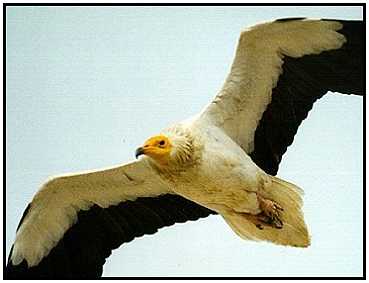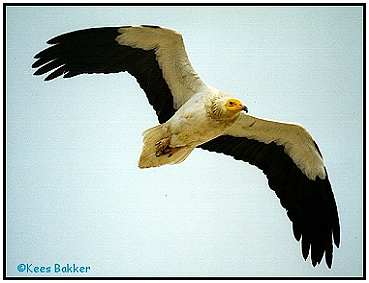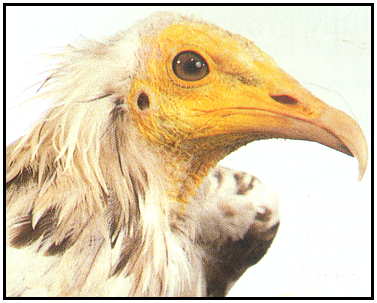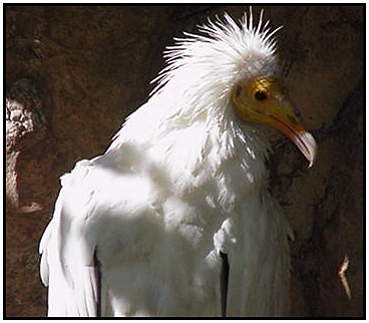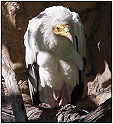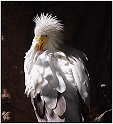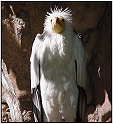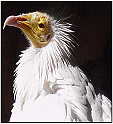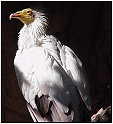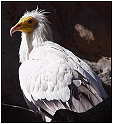EgyptianOrder: Falconiformes. Family: Accipitridae. (Old World vulture). Scientific Name: Neophron percnopterus. Common Names: Egyptian Vulture or 'Pharaoh's chicken'. (This bird has a long association with man and many drawings of it have been found on the walls of Egyptian tombs). Conservation Status: Rare. Declining within Europe, principally due to a lack of corpses to feed off, but also because of indiscriminate poisoning campaigns in many parts of its range. Rescue & Recovery: Captive breeding.
Egyptian Vulture (Photograph Courtesy of Kees Bakker Copyright ©2000)Geographical Range: India, Africa, a summer visitor to Southern Europe returning to Africa in the winter. Habitat: Rocky regions, often mountainous. Hills, lowlands, savannahs and semi-deserts. Occasionally seen around human settlements. Physical Characteristics: The Egyptian Vulture grows to around 60-70 centimetres long and has white plumage with black wing tips. It is a sociable bird and often to be found around villages or refuse dumps. The beak is thin with a blackish tip and the skin on the face and neck is yellowish. In young birds the plumage starts out a blackish brown colour and lightens over successive episodes of molting. Along with this, the skin on the throat and face gradually lighten up. It is not until they are six or seven years old that birds finally take on the full adult plumage. Unlike other vultures these birds do not require thermals to ride the air and so fly lower to search for carcasses.
Egyptian Vulture (Photograph Courtesy of Kees Bakker Copyright ©2000)Food: Feeds on carrion, rotten fruits, eggs (particularly those of the ostrich or flamingo), rubbish, snails, human excrement, also very partial to lion's dung, but shows little interest in the dung of hyenas or wild dogs (lion dung is more nutritious). Occasionally catches live prey in the form of locusts in flight, tortoises or lizards. Follows farmers plowing fields so it can catch disturbed insects. Often to be found hanging around slaughter houses.
Eqyptian Vulture (Copyright ©2000)The Egyptian Vulture has developed the ability to use an instrument and has become famed for its ability to open ostrich eggs using stones as missiles. Birds pick up stones in their bills and throw them forcefully towards the ground. Normally they miss, but this bird is nothing if not persistent. It is the only bird known to possess this ability, though in Australia Aboriginal folklore reports that the black-breasted buzzard drops stones onto emu eggs. As there is yet no scientific proof to confirm this it is still the subject of conjecture. (The breaking of the much smaller flamingo egg is an easy process, with the Egyptian Vulture scooping the egg up in its bill, carrying it aloft and dropping it to the ground). Debate exists over whether or not the Egyptian Vulture is performing an instinctive or a learned behaviour, but it seems that they will attempt to break open any egg-shaped object irrespective of what it is made of. Tests have been done using fibre-glass eggs, or eggs of various sizes and colours; the bird persisted with their attempts to open them. Captive Egyptian Vultures show no inclination to break Ostrich eggs in this manner, however even very young vultures pick up stones and toss them about. It may be that seeing another bird getting a meal from performing this action teaches youngsters what to do; the precise trigger for this activity remains unknown. It is also possible that in years when ostrich breeding is down, many young vultures simply never learn the behaviour as they do not see it demonstrated.
Egyptian Vulture (Photograph Courtesy of Linda Schueller Copyright ©2000)Reproduction: Performs display flights of dives and swoops prior to mating. Birds pair up for life and breed from mid-March to late August. My be found nesting at various altitudes from sea level up to 3,600 metres where it builds a crudely designed nest from branches, rags, feathers and other rubbish. The nests are usually located in rocks, small caves, or occasionally in trees and may be used several years running. If the nest of another species is vacant it may occupy that instead. At intervals of three or four days one or two, occasionally three, whitish or rusty-spotted eggs are laid. Incubation period is 42 days and this, along with the rearing of young, is done by both parents. The young are initially covered with white down, but quickly turn dark. They are able to fly at around 90 days. Thumbnails (Click For Full-Size Image):
|

